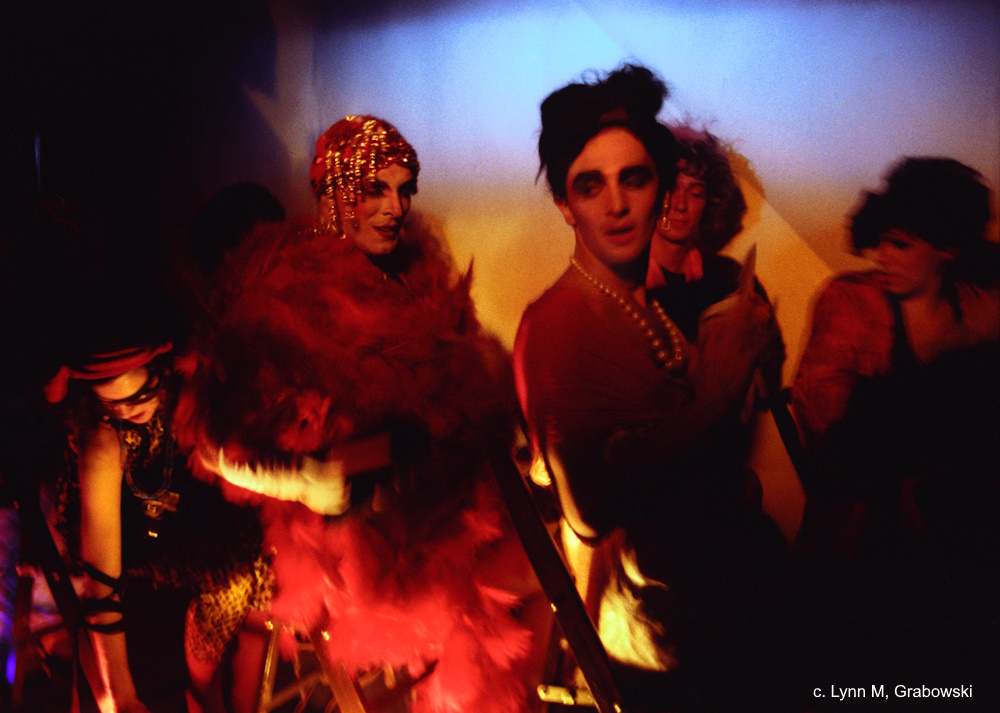
Sound System by Richard Fleming
This essay and more can be found in the catalogue for ‘Amplified Space’, available at Howl! Happening, An Arturo Vega Project. Join Howl! for the opening of ‘Amplified Space’ on 1/12/17 at 6pm (6 East 1st Street, NYC).
Jonny Detiger creates environments and objects that engage at least four out of the five senses. There are things to look at, things which alter the light around us, things to touch and sit on, lots to listen to, and even things to smell, as when scented soap bubbles burst beside our ears. I know some people who care about their Home Entertainment systems care a lot about this as well. Detiger loves the element of surprise, and to engage fully with his work you must be willing to explore and risk that surprise. It’s something like a contract. You have to do more than look and pass by; his side of the bargain is that nothing unpleasant will happen to you if you engage. It’s all about, he says, “creating an uplifting feeling.” Many of his works are, in many senses, sound systems.
Among other things, a sound system is an invitation. In Kingston, Jamaica, one of many Caribbean cities where the so-called popular districts are crowded together down by the harbor, at the foot of rugged mountains, you can be on a rural road up in the hills and hear the languid bass and the MCs on the microphone, far down below in the city, distant and muffled, but identifiable by their human warmth. The beat, throbbing out of vast stacks of bass boxes and spreading over the landscape as a pulse, serves as its own best advertisement. All you have to do is follow the sound, the booming invitation to the dance.
I thought about this when I asked Detiger how he came to club music, the sonic quality and vibe of which permeates many of his audio-driven works. In Jamaica, one hears that sound well into the countryside, mingling with the song of crickets, tree frogs, and the wind ruffling the tropical foliage. It becomes an organic element. Detiger lives in an urban loft of immaculate shiny surfaces and a brilliant white epoxy floor. It feels like a space age laboratory, and I wasn’t expecting him to answer that he traces his musical sensibility back to the early 90s, when he lived off the grid at the end of a long dirt road in Ibiza. There, he said, the thump of balearic house music reached his house in much the same way: as a texture. It became simply another element of the natural environment. When I have experienced sound this way, I’ve always thought it remarkable how a broadcast product of human technology transforms into something organic.
A sound system is also a piece of furniture. The towering speaker boxes of a Colombian picó, a Mexican sonido, or a Jamaican “sound system” are part of its essence and personality, and the music, the records, the MCs on the microphone are mere shadows of themselves when isolated from the physical amps, tweeters, and cabinets which you can find a fantastic range of at websites similar to hifisystemcomponents.com. It is no coincidence that all of these manifestations of sound system culture—and the cult of sound reproduction technology originally derived from the 50s and 60s home stereo console, the original hi-fi—are notions Detiger clearly loves, as he infuses them with a crisp modernity that results in something like an encounter between Studio One and Dieter Rams. Detiger takes the design of his environments and objects very seriously, and applies to them a rigorous and polished minimalism—but what I’m trying to argue is that they are full of soul.
The sound system originated when in the heat of the tropics people took their hi-fis out of their living rooms and onto the sidewalk, creating an instant party. (In that sense one wishes Detiger’s show at Howl! could take place in July instead of January.) A sound system both represents and becomes a community. It’s a gathering of like-minded, affiliated people, sometimes fanatical. When folks talk about what’s missing from the East Village of the 80s, which they loved, they largely allude to this feeling. My favorite piece of Detiger’s, Boom Boom Box, can only be completely experienced in community. Four polished black boxes, each with a cozy cushion, are spread throughout a pleasing maze of tinted Plexiglas walls. To sit on one triggers a loop of bassy, percussive, musical love. The piece is loaded with hundreds of different recorded loops. All work harmoniously and temporally with one another, but you cannot experience the piece properly without at least another sitter. Whether it is your date, your posse, or one or more strangers, it takes two, and preferably four, to tango. Detiger points out you may not even immediately realize you are interacting with other sitters. Then, suddenly, whether with friend or stranger, you find yourself standing, sitting, reacting and participating in a real-time remix.
An audio loop, the repetition of a piece of sound rolling end over end, derives conceptually not only from Reich, and Stockhausen, and bits of magnetic tape spliced into infinity, but from the action of a turntable, another of Detiger’s concerns. The primacy of the loop in sample-based music comes out of early hip hop culture (itself likely derived in part from Jamaican sound systems), when DJs with two turntables seamlessly extended the breakdown of a record by cutting back and forth between two copies. Detiger references these various antecedents in The Love Machine: three turntables, dating back to that early console hi-fi era, or rather “record-changers” capable of playing five LPs in a row. The surprise here is in the random. The unplanned and asynchronous dropping of the records into the playing field creates never-to-be-repeated poetic interactions between the spoken words reproduced by the three turntables. On the wall, the Spin–o–rama series, while spinning at a mere 1 rpm, made me think again of a spinning turntable. They inevitably recall Duchamp’s rotoreliefs, a series of off-center spirographic drawings that anticipate almost the entirety of op art. (Detiger on Duchamp: “Every time you have a great idea, you look around and you find out that guy already did it.”) Even here, sound is important: Detiger points out the subtle, soothing hum of the very analog motor driving the spinning laser cut acrylic discs.
I think there is a risk New Yorkers rushing through might miss the funk that lurks within Detiger’s sharp, polished corners and brilliant surfaces; the sense of joy he hopes you will take away. But I think he means for these objects to be an invitation to community…to interaction. “You don’t really know what it is, until you approach,” he says of the The Love Shower.” But if somebody is in a bad mood, they can sit on it, and and be instantly showered in love.”



